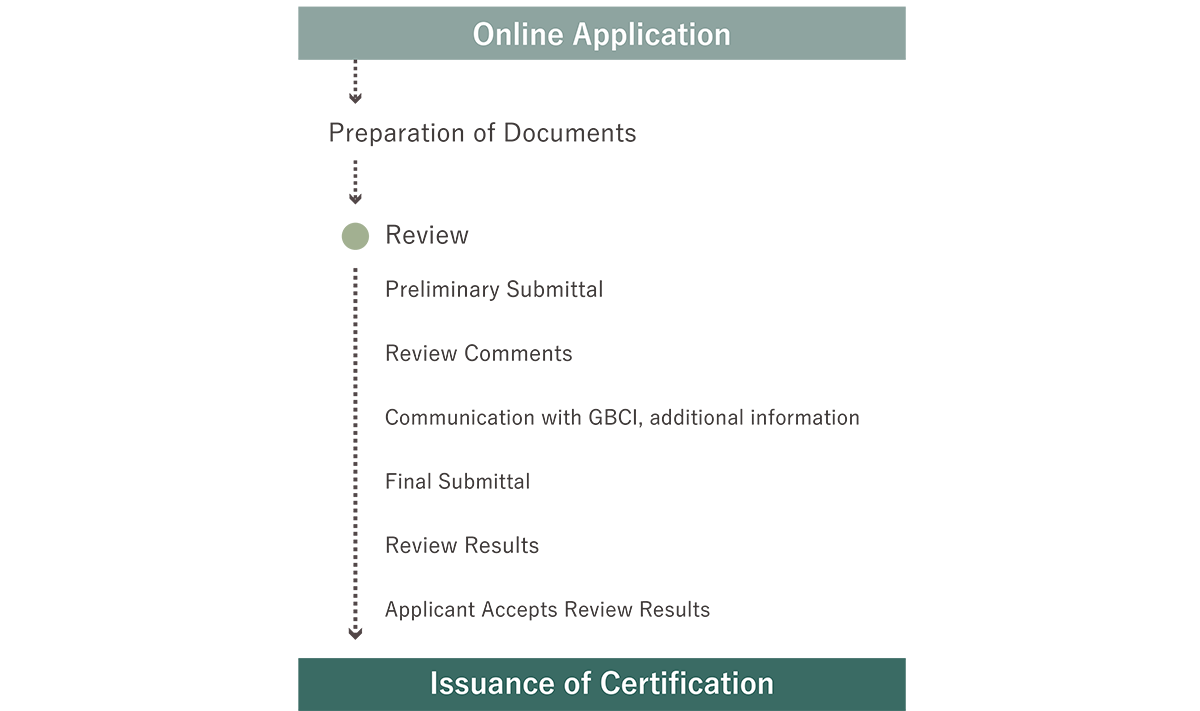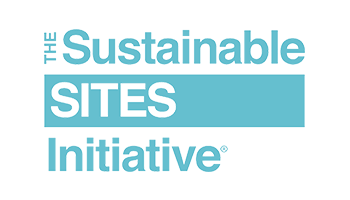1. What is SITES®
SITES® is a comprehensive framework for designing, developing, and managing sustainable and resilient landscapes; it is also a certification system for evaluating such landscapes. Similar to LEED® and WELL, the review and certification are performed by the Green Business Certification Inc.™ (GBCI®), a US organization. The design of the system was mainly carried out by the American Association of Landscape Architects (ASLA), the United States Botanic Garden, the Lady Bird Johnson Wildflower Center, etc. The trial started in 2009 as version 1 for projects in the United States. Subsequently, the United States Green Building Council (USGBC®), which is in charge of designing and updating the LEED® system, also coordinated the evaluation items, and from version 2 (hereafter referred to as v2) announced in October 2015, the scope of certification has been expanded beyond the United States.
Official name of SITES®: Sustainable SITES Initiative®
2. Eligible Projects
Nearly any project that has an outdoor space that is newly developed or undergoing a major renovation is eligible for SITES®. It does not matter whether there is a building or not, so in addition to outdoor spaces in condominiums, office buildings, commercial facilities, and schools, parks, squares, and street spaces can also be certified under SITES®. There is a minimum floor space requirement of 2,000 square feet, but no upper limit. The project scope is basically the site boundary line, but if the scope is reasonable, it is also possible to set an arbitrary range or multiple consecutive SITES® as the project scope.
As mentioned above, SITES® v2 was developed for outdoor spaces that are newly developed or undergoing major renovations. A pilot version of SITES® for Existing Landscapes has been in operation since 2022. SITES® for Existing Landscapes is for outdoor spaces with a track record of operation for more than one year, and there are no minimum or maximum area requirements.
3. Evaluation Items
SITES® v2 has 10 sections with mandatory items and additional credits (some sections do not have mandatory items) and consists of 18 mandatory items and 48 additional credits. The total score for the credits is 200 points for Sections 1-9 plus 9 bonus points for Section 10 totaling 209 points. Like SITES® v2, SITES® for Existing Landscapes also consists of 10 sections, but each section has a different point allocation system and is evaluated out of 175 points.
SITES® v2 also evaluates the entire project, from early planning through design, construction, operation, and management. Acquisition of certification or high-ranking certification requires a multifaceted consideration, rather than consideration of a single point, therefore evaluation viewpoints are extremely multifaceted, including biodiversity conservation, water resource conservation, energy conservation, resource recycling, heat island phenomenon mitigation, health promotion, and education.
Site Context
This section evaluates whether the target land is suitable for development. Rather than developing in natural areas, an existing development site without precious living organisms or ecosystems is preferred. An area where people do not rely on automobile transportation is considered desirable; the availability of public transportation and convenient facilities for a variety of purposes in the surrounding area also results in positive evaluations.
Pre-Design Assessment + Planning
This is the section where the planning process is evaluated. The essential requirements include forming a team of diverse experts, setting goals, surveying the target area, and designating vegetation and soil protection zones. Additional points include content related to sharing (disclosure) of the plan with stakeholders.
Site Design – Water
This section deals with infiltration and storage of rainwater on-site, reduction of irrigation volume, conservation of aquatic ecosystems, etc. Especially for rainwater, it is essential to have a rainwater drainage plan that permeates and stores the 60th percentile rainfall without letting it out of the site.
Site Design – Soil + Vegetation
Conservation of existing soil and vegetation, use of native species, conservation of rare plants, hierarchical structure of vegetation, etc. are the points of evaluation in this section. Mitigation of the heat island effect and reduction of building energy consumption through shade and windbreaks are also included in the evaluation items in this section.
Site Design - Materials Selection
This section evaluates the materials used. It is a mandatory requirement not to use endangered species of wood. Additionally, the use of existing plants, recycled materials, locally produced materials, and choosing of companies that are engaged in sustainable raw material extraction, manufacturing, and plant production will be evaluated as additional points.
For SITES® for Existing Landscapes, it is necessary to create a "material procurement policy" that assumes future repair work and renovation work.
Site Design – Human Health + Well-being
This section evaluates the use of outdoor spaces by people and their contribution to health promotion. Accessibility (barrier-free support) and safety, availability of seating spaces and spaces for physical activity, food production, reduction of light pollution, management of smoking areas, the establishment of priority parking lots for fuel-efficient vehicles, etc. are also evaluated.
Construction
This section evaluates sustainable efforts at the construction stage. The essential requirements are that the construction site is properly managed to prevent soil and pollutants from flowing out and that the soil disturbed by construction activities (the area that will eventually become a planting area) is regenerated. Reuse of waste materials generated during demolition and construction using low-emission equipment are evaluated as additional points. For SITES® for Existing Landscapes, there is a requirement to create a construction policy that estimates future repair work and renovation work.
Operation + Maintenance
Developing a sustainable maintenance plan and securing a storage site for renewable materials are essential requirements. Reuse of organic matter (plant residue and food waste), reduction of pesticides and chemical fertilizers, the introduction of equipment with low energy consumption, use of renewable energy, reduction of usage time and amount of power equipment, etc. are evaluated as additional points.
Education + Performance Monitoring
This section evaluates sustainability education, project information disclosure, and monitoring. It is necessary to create materials and signs that can teach about the sustainable characteristics of the target site, publish information on the web and at meetings, and implement various types of monitoring activities.
SITES® for Existing Landscapes has an additional 'Landscape Performance Evaluation' credit, which is assigned a large number of points.
Innovation or Exemplary Performance
If there is a sustainable initiative that cannot be evaluated within the framework of Sections 1-9, it is possible to obtain bonus points in this section in the form of a proposal to the certification body. Alternatively, points can be obtained if the performance greatly exceeds the threshold set for each evaluation item.
*Icon images reprinted from the GBCI® SITES® Reference guide
4.SITES® Accredited Professional
SITES® Certified Professional (SITES® AP) is a qualification held by those who have passed the GBCI® exam to test their knowledge of the Sustainable SITES Initiative®. Woonerf Inc has several accredited personnel.

5. Process
Since the certification body is GBCI®, the same as LEED® and WELL, the certification process is also similar in many respects to these certification schemes. After registering for the project, you can submit the application documents. After submitting the application documents for all prerequisites and optional credits, a review will be conducted by the reviewing organization. The review is divided into a preliminary and final review. When the final review is completed, a certification level is given according to the total score of the credits.


6. Certification levels
SITES® v2 is evaluated in four levels: Certified, Silver, Gold, and Platinum, depending on the points scored in the credits after meeting all the prerequisites Scores of 70, 85, 100, and 135 or higher are required respectively. The certification level threshold for SITES® for Existing SITES® is the same as for SITES® v2.

7. Fees
To obtain SITES® certification, in addition to the consulting fee, project registration and audit fees are required. Unlike LEED® and WELL, there is no cap on area requirements, and project costs are essentially the same regardless of area. However, if the project area exceeds 100 acres (approximately 40.5ha), there will be an additional charge. Please refer to the link below for cost details.
SITES® certification fee:https://sustainablesites.org/certification-guide
(Please inquire separately about SITES® for Existing Landscapes.)

 Page Top
Page Top